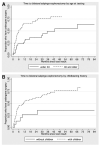Uptake and timing of bilateral prophylactic salpingo-oophorectomy among BRCA1 and BRCA2 mutation carriers
- PMID: 18344704
- PMCID: PMC4199586
- DOI: 10.1097/GIM.0b013e318163487d
Uptake and timing of bilateral prophylactic salpingo-oophorectomy among BRCA1 and BRCA2 mutation carriers
Abstract
Purpose: To evaluate prophylactic salpingo-oophorectomy uptake and timing among BRCA1/2 mutation carriers in a cancer risk assessment program.
Methods: Clinical records of female BRCA1/2 mutation carriers who received cancer genetic counseling between 1996 and 2003 were reviewed to determine the completion and the timing of prophylactic salpingo-oophorectomy. Logistic regression models evaluated associations between subject characteristics and surgery. Survival analysis methods were used to estimate the distribution of time to surgery.
Results: Among 88 women, 70% underwent prophylactic salpingo-oophorectomy. Prophylactic salpingo-oophorectomy was associated with older age, white race, having children, and a family history of ovarian cancer. Many women waited more than 12 months to undergo surgery and some delayed by several years. Younger age and not having children were associated with delays to surgery.
Conclusion: Prophylactic salpingo-ooporectomy is an acceptable risk reduction measure for many BRCA1/2 mutation carriers. Some women make this decision many years after genetic testing. Continued discussion of the risks and benefits of risk reduction options may facilitate the uptake of recommended risk reduction interventions among BRCA mutation carriers.
Figures
References
-
- Whittemore AS. Risk of breast cancer in carriers of BRCA gene mutations. N Engl J Med. 1997;337:788–789. - PubMed
-
- American Cancer Society . Cancer facts and figures 2007. American Cancer Society; Oakland, CA: 2006.
Publication types
MeSH terms
Grants and funding
LinkOut - more resources
Full Text Sources
Miscellaneous



